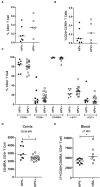HPV Induces Changes in Innate Immune and Adhesion Molecule Markers in Cervical Mucosa With Potential Impact on HIV Infection
- PMID: 33013878
- PMCID: PMC7494736
- DOI: 10.3389/fimmu.2020.02078
HPV Induces Changes in Innate Immune and Adhesion Molecule Markers in Cervical Mucosa With Potential Impact on HIV Infection
Abstract
While most HPV infections are asymptomatic and clear spontaneously, persistent infection with high-risk HPVs is associated with cervical cancer and with increased risk of HIV acquisition. Although several hypotheses have been proposed to explain this phenomenon, none has been confirmed. Our aim was to investigate the expression of host factors involved in the susceptibility to HIV infection among HPV-infected women. Cervical samples were collected to characterize the expression levels of HIV susceptibility markers in the mucosa of HPV-infected compared with HPV-uninfected women. No differences in the frequency of CCR5+, integrin α4β7+, activated and memory CD4+ T-cell were detected between the groups. We additionally evaluated the expression levels of genes involved in innate immune responses and in cell adhesion. HPV infected patients expressed higher levels of TLR9 and lower levels of pattern recognition receptors that recognize RNA (TLR3, TLR7, and MDA5/IFIH1). We also detected an impaired IFN pathway, with an increased Type I IFN and a decreased IFNα2 receptor expression. HPV+ samples displayed reduced expression of genes for adherens and tight junctions. Taken together, these results suggest that although HPV infection does not result in the recruitment/activation of susceptible CD4+ T-cell in the female genital tract, it leads to changes in the innate antiviral immune responses and in cell adhesion that are likely to favor HIV infection.
Keywords: HIV; HPV; cell junctions; innate immunity; interferon type I; toll-like receptors.
Copyright © 2020 Britto, Goes, Sivro, Policarpo, Meirelles, Furtado, Almeida, Arthos, Cicala, Soares, Machado and Giannini.
Figures





Similar articles
-
Depletion and activation of mucosal CD4 T cells in HIV infected women with HPV-associated lesions of the cervix uteri.PLoS One. 2020 Oct 2;15(10):e0240154. doi: 10.1371/journal.pone.0240154. eCollection 2020. PLoS One. 2020. PMID: 33007050 Free PMC article.
-
Distribution of immune cell subsets and cytokine-producing cells in the uterine cervix of human papillomavirus (HPV)-infected women: influence of HIV-1 coinfection.Diagn Mol Pathol. 2005 Mar;14(1):39-47. doi: 10.1097/01.pas.0000143309.81183.6c. Diagn Mol Pathol. 2005. PMID: 15714063
-
Proinflammatory and type 1 cytokine expression in cervical mucosa during HIV-1 and human papillomavirus infection.J Acquir Immune Defic Syndr. 2007 May 1;45(1):9-19. doi: 10.1097/QAI.0b013e3180415da7. J Acquir Immune Defic Syndr. 2007. PMID: 17356467
-
Immune response in cervical dysplasia induced by human papillomavirus: the influence of human immunodeficiency virus-1 co-infection -- review.Mem Inst Oswaldo Cruz. 2005 Feb;100(1):1-12. doi: 10.1590/s0074-02762005000100001. Epub 2005 Apr 12. Mem Inst Oswaldo Cruz. 2005. PMID: 15867955 Review.
-
[Role of Toll-like receptors in persistent infection of cervical high-risk human papillomavirus based on "latent pathogen theory"].Zhongguo Zhong Yao Za Zhi. 2025 Apr;50(7):1974-1979. doi: 10.19540/j.cnki.cjcmm.20250109.501. Zhongguo Zhong Yao Za Zhi. 2025. PMID: 40350890 Review. Chinese.
Cited by
-
Oral Papillomatosis: Its Relation with Human Papilloma Virus Infection and Local Immunity-An Update.Medicina (Kaunas). 2022 Aug 15;58(8):1103. doi: 10.3390/medicina58081103. Medicina (Kaunas). 2022. PMID: 36013570 Free PMC article. Review.
-
Patterns of Different Cervical Cytokine Expression in High-Risk Human Papillomavirus-Infected Patients With Cervical Cancer and Its Precancerous Lesions.Clin Med Insights Oncol. 2025 Mar 25;19:11795549251316767. doi: 10.1177/11795549251316767. eCollection 2025. Clin Med Insights Oncol. 2025. PMID: 40144778 Free PMC article.
-
Dysbiosis of Cervical and Vaginal Microbiota Associated With Cervical Intraepithelial Neoplasia.Front Cell Infect Microbiol. 2022 Feb 14;12:767693. doi: 10.3389/fcimb.2022.767693. eCollection 2022. Front Cell Infect Microbiol. 2022. PMID: 35237529 Free PMC article.
-
Involvement of TLR9 in priming the immune response in oral papillomatosis induced by low-risk HPV.Rom J Morphol Embryol. 2023 Apr-Jun;64(2):181-188. doi: 10.47162/RJME.64.2.08. Rom J Morphol Embryol. 2023. PMID: 37518875 Free PMC article.
-
Targeted degradation of the HPV oncoprotein E6 reduces tumor burden in cervical cancer.bioRxiv [Preprint]. 2024 Oct 17:2024.10.17.618959. doi: 10.1101/2024.10.17.618959. bioRxiv. 2024. PMID: 39464070 Free PMC article. Preprint.

